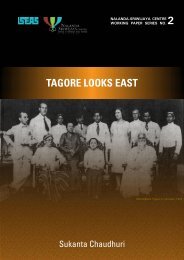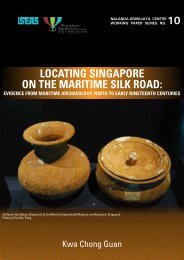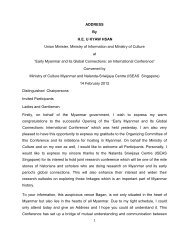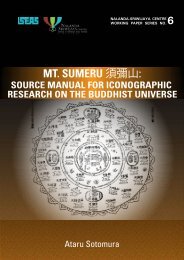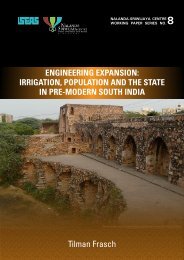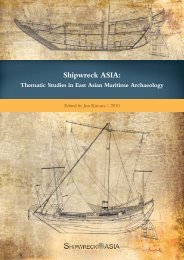provenance research on 14th-century greenwares found in singapore
provenance research on 14th-century greenwares found in singapore
provenance research on 14th-century greenwares found in singapore
Create successful ePaper yourself
Turn your PDF publications into a flip-book with our unique Google optimized e-Paper software.
Stulemeijer: Provenance Research <strong>on</strong> <strong>14th</strong>-Century Greenwares Found <strong>in</strong> S<strong>in</strong>gapore NSC Work<strong>in</strong>g Paper No. 9<br />
5.3. Archaeological data<br />
In 1984, Dr. John N. Miksic c<strong>on</strong>ducted the first scientific archaeological excavati<strong>on</strong> <strong>in</strong><br />
S<strong>in</strong>gapore. Over the next twenty years he would lead many more teams of volunteers <strong>in</strong><br />
unearth<strong>in</strong>g parts of ancient S<strong>in</strong>gapore.<br />
At the start of my <str<strong>on</strong>g>research</str<strong>on</strong>g> the artefacts recovered from the Fort Cann<strong>in</strong>g (FTC) excavati<strong>on</strong>s<br />
were under post-excavati<strong>on</strong> <strong>in</strong>vestigati<strong>on</strong> and thus the excavated artefacts are not <strong>in</strong>cluded<br />
<strong>in</strong> this study. Sherds from the two excavati<strong>on</strong> sites further discussed <strong>in</strong> this paper are<br />
Empress Place (EMP) and the S<strong>in</strong>gapore Cricket Club (SCC). These were used for the<br />
purpose of this <str<strong>on</strong>g>research</str<strong>on</strong>g>, as they were able to supply the<br />
number of sherds required to satisfy scientific statistical<br />
requirements for such <str<strong>on</strong>g>research</str<strong>on</strong>g>.<br />
5.3.1. Empress Place (EMP)<br />
This site is currently better known as the locati<strong>on</strong> of the Asian<br />
Civilisati<strong>on</strong>s Museum. The excavati<strong>on</strong> site at EMP was<br />
located <strong>in</strong> between the current museum and the river. This<br />
patch of grass was excavated <strong>in</strong> 1998 and, as shown <strong>on</strong> the<br />
map <strong>in</strong> figure 2, is just <strong>in</strong>side the mouth of the S<strong>in</strong>gapore<br />
River (covered by the Esplanade Bridge).<br />
Dur<strong>in</strong>g the<br />
excavati<strong>on</strong>, it became apparent that there were two dist<strong>in</strong>ct<br />
occupati<strong>on</strong>al layers. The first habitati<strong>on</strong> layer (count<strong>in</strong>g from the top) was determ<strong>in</strong>ed as<br />
c<strong>on</strong>ta<strong>in</strong><strong>in</strong>g artefacts from the Dutch VOC Company (Dutch East India Company) <strong>in</strong>clud<strong>in</strong>g<br />
co<strong>in</strong>s and Ch<strong>in</strong>ese porcela<strong>in</strong> from the latter half of the 18 th <strong>century</strong>. Artefacts from this era<br />
have not been retrieved from any other archaeological site <strong>in</strong> S<strong>in</strong>gapore.<br />
Figure 2:<br />
Empress Place<br />
Excavati<strong>on</strong> Site street<br />
Streedirectory.com<br />
The sec<strong>on</strong>d habitati<strong>on</strong> layer was dated from the late 13 th to mid-15 th <strong>century</strong>. This was<br />
determ<strong>in</strong>ed by stylistic analysis of Ch<strong>in</strong>ese porcela<strong>in</strong> and comparis<strong>on</strong> with samples of known<br />
data <strong>found</strong> <strong>in</strong> Ch<strong>in</strong>a. EMP is situated just <strong>in</strong>side the mouth of the S<strong>in</strong>gapore River. It is likely<br />
that this area was a large sandbar that just rose above the water at normal high tide. From<br />
the excavati<strong>on</strong> at EMP an estimated 40,000 artefacts were unearthed (Miksic & Low 2004).<br />
18






